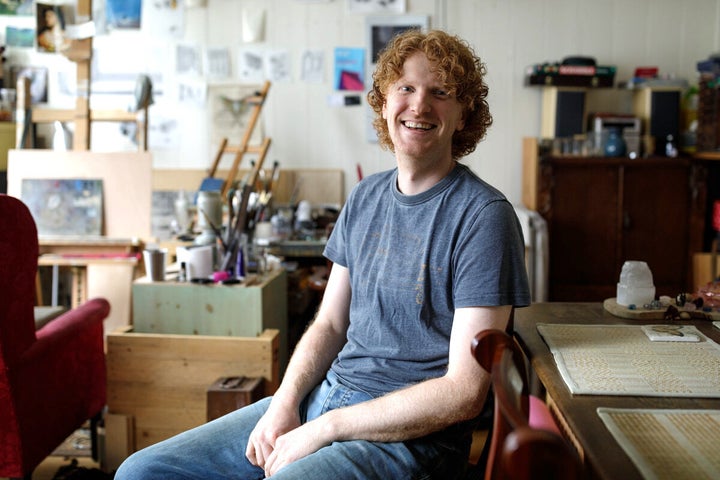
During his worst flare-ups, Daniel Morley lies in bed wondering if he should just go thirsty. He desperately wants a glass of water, but his body is in so much pain, he can’t bear to move the five metres to the sink. His joints are on fire.
Rheumatoid arthritis (RA), which Morley was diagnosed with at the age of 19, is a long-term condition that causes swelling and stiffness in the joints – usually the hands, feet and wrists. The immune system mistakenly attacks cells lining the joints, causing intense pain that makes it hard for some sufferers to leave the house.
Dr Vijay Hajela, consultant rheumatologist at the Lister Hospital, tells HuffPost UK the condition is most common among those aged 20 to 60 years old, with women three times more likely to develop it than men. Currently, 2.7 million people under the age of 35 in the UK have arthritis or a related condition.
“Arthritis has a huge impact, both physically and emotionally, on people living with the condition,” says a spokesperson for the charity Versus Arthritis, which offers advice and support to those struggling. “If you’re in early adulthood or of child-bearing age, it can affect your education, career prospects, relationships and prevent you from planning for the future.”
[Read More: What it’s like to experience sight loss in your 20s]
Of course, growing up with a condition like arthritis – which is incorrectly viewed as an “old person’s disease” or “just a bit of joint pain” – can be hard. “Because of this, people feel embarrassed or ashamed and don’t talk about their condition and ask for help,” the spokesperson says.
We asked three millennials aged 25-35 to share what life is like with the chronic condition.
‘I had to leave my job because of it’

Morley’s ankles and knees are the joints most impacted by RA – they swell up, making it hard for him to stand, walk or drive. The former chef, from Frome, had to quit his job due to the constant pain. He’s now self-employed.
He first noticed something was wrong as a teenager when his knees swelled up and his ankles started causing him pain. During this time he took almost nine months off work. Morley was eventually referred to a specialist consultant, who drained fluid from his joints and gave him steroid injections.
Since then, the 35-year-old says he tends to have periods of time where he won’t be in pain – then it will suddenly flare up again. “This time last year, my ankle had swollen up so much it had pushed to the side,” he says. “I had to leave my job because of it.”
RA has impacted his relationships, too – he recalls how an ex found it hard to empathise with him when he found it too painful to get up and answer the front door.
The main treatment options for RA include medication, supportive treatments like physiotherapy, and surgery to correct joint issues. Over time, Morley has tried steroid injections, immunosuppressants and various medications to manage the pain. At one point, he was on nine different types of tablet. “It got to a point where I was like, ‘this is ridiculous’,” he says.
More recently, Morley has changed his diet – which he says has helped – but he’s also mindful that during a flare-up, he can’t be as active as he’d like. “I now only really get it in one or two joints,” he adds.
‘Making sure I’m fit for work every day is a struggle’

Debbie Griffin, 32, from north Wales, was diagnosed at just two years old. She recalls realising something wasn’t quite right when she was five. “I was making friends in school and noticed I couldn’t do the things everyone else could do, like sports day,” she says.
RA typically causes pain in several joints, although it may start with just one large joint such as a knee or shoulder, according to Dr Hajela. “The joints often swell, feel warm and are tender,” he says. “The pain and stiffness are classically worse in the morning, making it difficult to get out of bed.” Sufferers might also experience fatigue and feel like they have flu. Over time, the condition can damage the joint, cartilage and nearby bone.
Griffin experienced problems with her hips and knees during her early teens, to the point where she struggled to move even a few feet without being in pain. At 13 she had to have a knee replacement, followed by a hip replacement at 17.
“It impacts my life daily,” says the 32-year-old. Some days, she will wake up without any issues; other days she will be in so much pain she can’t leave the house. “Making sure I’m fit for work every day is a struggle,” says the service manager, who works for a national charity.
At the moment her elbow joint is particularly bad, so she’s using her other arm to carry out tasks many others take for granted – like making a cup of tea. Life for Griffin is all about adapting and finding ways to make daily tasks a little easier – she has a raised toilet seat in her home and a handy jar opener.
“There are so many things out there that can help you,” she says, “although I think younger people don’t want to be seen with them.”
‘People forget because they can’t see anything’s wrong with you’

Louisa Flannery, from Leeds, was diagnosed with RA in the run-up to her GCSEs. Initially, she experienced a pain in her feet, and was told to wear insoles, but when it began to continue up her body to her knees, she was referred to a specialist. She was diagnosed at 15, after a year and a half.
As a teenager, Flannery found it hard being heard by the adults around her. She recalls having to miss PE lessons because of the pain. “I didn’t know what was wrong with me, so it was difficult to communicate with the teachers – I think they thought I was just using it as an excuse,” she says. “The invisible part of it is quite difficult. People forget because they can’t see anything’s wrong with you.”
Now studying for a Masters degree, Flannery, 25, struggles with constant pain in her ankles and shoulders, as well as her back and knees from time to time. “My hands are swollen and a bit disfigured,” she says, noting that it’s quite hard to write. ”I usually do computer work which is fine.”
Dr Hajela says this isn’t uncommon. Daily activities such as going up and down stairs, preparing a meal, getting dressed and even washing and brushing teeth can be impacted. “Most find that it takes them longer to get ready in the morning,” he adds. “I recall one lady who had to set her alarm two hours earlier than normal in order to try and still make it in for work at 9am.”
Flannery manages her symptoms through exercise – going to the gym four times a week – and taking regular medication, but has to be mindful about standing up for long periods of time and will often find somewhere to rest if she’s out with friends.
With a combination of medication and lifestyle changes, many people with RA can live relatively normal lives. Dr Hajela describes effective treatment as “miraculous” and has never forgotten what one of his patients told him: “I was scared of the medication at first, but it has given me my life back.”